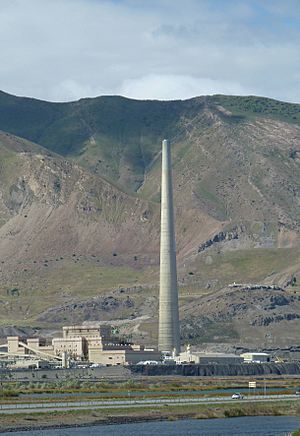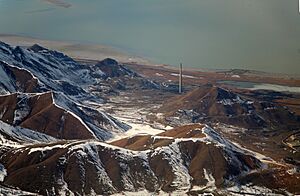Kennecott Garfield Smelter Stack facts for kids
The Garfield Smelter Stack belongs to Kennecott Utah Copper LLC. It is a very tall smokestack, about 1,215 feet (370 meters) high. You can find it west of Magna, Utah, right next to Interstate 80. It's also quite close to the Great Salt Lake. This huge chimney was built to release exhaust gases safely. These gases come from the Kennecott Utah Copper smelter in Garfield, Utah. A smelter is a special factory that uses heat to get metal out of rock.
Contents
Why the Tall Stack?
The Garfield Smelter Stack was completed in 1974. It replaced several older, shorter smokestacks. The tallest of the old stacks was only about 413 feet (126 meters) high.
Meeting Clean Air Rules
The new, much taller stack was needed for an important reason. New rules from the Clean Air Act of 1970 required it. This law aimed to make the air cleaner. The taller stack helps spread out the exhaust gases. This way, they mix with more air before reaching the ground.
Cleaner Air Today
Over the years, rules for clean air became even stricter. In 1995, the smelter got a new, cleaner furnace. This new furnace helps reduce pollution a lot. The amount of sulfur dioxide released from the stack has dropped greatly.
The gases from the furnace are now cleaned very well. They go through a special system. This system removes most of the harmful sulfur dioxide. In fact, more than 99.9% of the sulfur is captured.
Turning Waste into Something Useful
What happens to the captured sulfur dioxide? It's turned into something useful! The company makes sulfuric acid from it. Sulfuric acid is used in many industries. In 2006, the company produced about 833,000 tons of this acid. This shows how they turn waste into a valuable product.
The process also helps make electricity. About 24 megawatts of power are generated. This provides about 70% of the smelter's electricity needs. It's a great example of recycling and energy saving.
Building the Giant Stack
The Garfield Smelter Stack is truly massive. It is 177 feet (54 meters) wide at the bottom. Its walls are 12 feet (3.7 meters) thick there. As it goes up, it gets narrower. At the very top, it is 40 feet (12 meters) wide and its walls are 12 inches (0.3 meters) thick. A large fiberglass pipe runs up the inside. This pipe carries the gases to the top.
Construction Facts
Building this stack was a huge project. Workers used about 26,317 cubic yards (20,120 cubic meters) of concrete. They also used 900 tons (816 metric tons) of steel. Construction started on August 26, 1974. It was finished on November 19, 1974. The concrete pouring took 84 days. The whole project cost $16.3 million back then. That would be about $78.7 million today.
Reaching the Top
There's a special elevator inside the stack. It was built in Sweden. This elevator slowly climbs up a gear track on the inner wall. It takes about 20 minutes to reach the very top. However, workers usually only go up to the 300-foot level. That's where they check the air-sampling station every day.
A Record-Breaking Structure
The Garfield Smelter Stack holds some impressive records. It is the tallest free-standing structure west of the Mississippi River. It is also the fourth tallest smokestack in the entire world. On top of that, it ranks as the forty-third tallest free-standing structure on Earth. It is the only working smelter chimney left in Utah.



